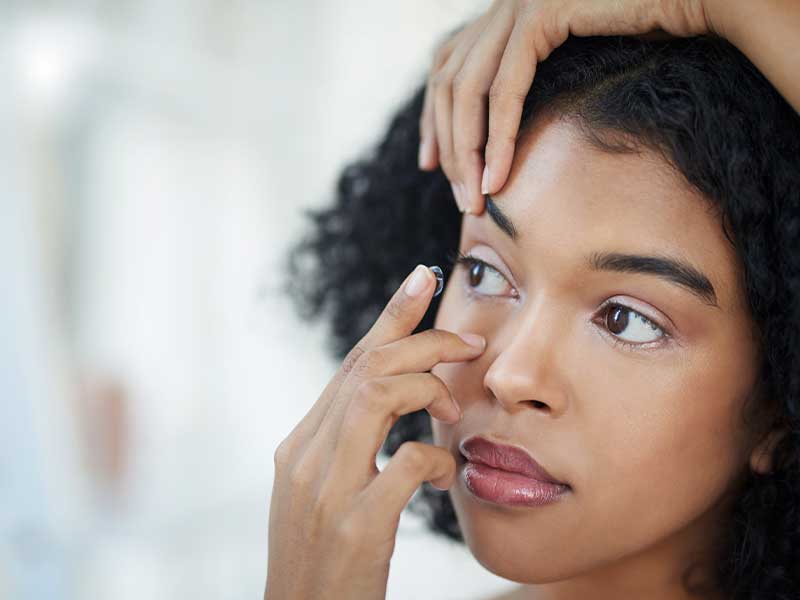Contact lenses correct refractive errors, such as nearsightedness and farsightedness. They are thin plastic or silicone that rest directly on your eye. The type of lenses you need depends on your vision needs. Unlike eyeglasses, they move with your eyes and do not fog up due to temperature changes.

If you are a first-time contact lens wearer, you might need some time to get used to handling them. Once you’ve adjusted, wearing the lenses and taking them off would be a breeze. Here are helpful tips from your local eye specialist.
Preparing to Put In Contact Lenses
 Have the Appropriate Contact Lens Solution
Have the Appropriate Contact Lens Solution
You clean and disinfect your contact lenses with the solution provided by your eye doctor. Never use tap water to clean and store your contacts. It could contain microorganisms that can cause eye infections.
Wash Hands Thoroughly
Good hygiene is essential to safe contact lens wear. Always wash and dry your hands before handling contacts. Avoid using scented and oil-based soaps for cleaning your hands. Also, use a lint-free cloth to dry them.
Remove Contact Lenses From the Case
It’s a good idea to check your prescription for any written instructions from your eye doctor. After opening the case, gently dip your index finger to lift and take each lens out. Be careful handling your contacts to avoid scratches and tears that can cause discomfort.
How to Put In Contact Lenses

Wear Your Lenses
Before wearing your lenses, be sure to lubricate them. Position the lens on the tip of your index finger. Using your middle finger, gently tug your lower lid with the same hand that has the lens. Keep your upper lid in place using your other hand. Put the lens on your eye’s iris, remove your fingers from your lids and blink a couple of times.
Adjust the Lens if Necessary
If your lenses are uncomfortable or do not seem to be in place, blink several times until they are in position. It may also help to look up, down, left and right for around five seconds. You might need to re-try putting on your lenses if you still experience discomfort.
How to Take Out Contact Lenses

Remove Your Contact Lenses
Again, wash and dry your hands before touching contacts. Pull down your lower lid and look up. Carefully reposition the lens to the sclera or white of the eye and slowly lift it to take it out.
Clean and Store Them Properly
Usually, eye doctors recommend using a multipurpose solution to clean, rinse and store your contacts. Some types of contact lenses require different kinds of solutions. Only use products advised by your eye specialist. Fill the case with the prescribed solution before storing your lenses.
Caring for Contact Lenses
 Know What to Do if Your Lenses Cause Pain
Know What to Do if Your Lenses Cause Pain
Besides being out of place, contact lenses can cause discomfort if they are inside out or have debris on them. Remove the affected lens and use the solution to clean it before putting it back on. If you already have irritated eyes, it is best to discontinue wear. You will need to visit your eye clinic if the irritation persists.
Replace Lenses as Directed
What kind of contact lenses do you wear? If you have daily disposables, you must get rid of them after use. Weeklies require replacement every one or two weeks. Moreover, you need to replace monthly disposable lenses after 30 days. When you fail to follow your contact lens replacement schedule, you could experience various eye problems, including irritation and irreversible vision loss.
Be Mindful of Contact Lens Solution Expiration Date
You should never use contact lens solutions past their expiration date. Also, check the discard date on the packaging or bottle of your solution. Seek assistance from your optometrist if you’re unsure when to dispose of it.
Don’t Sleep Without Taking Off Your Contact Lenses
Your risk for eye infections can increase up to eight times when you sleep in your contact lenses. Blinking helps supplement your eyes with the lubrication they need when you are awake. However, you are not blinking when you are asleep. Having contact lenses in your slumber will keep oxygen and tears from reaching certain areas of your eyes. Over time, the lack of oxygen can lead to hypoxia. When this happens, the cornea will fail to kill bacteria.
Remove Your Contacts Before Swimming
You should not wear contact lenses when getting in a hot tub, pool or any body of water. Bacteria, viruses and other harmful microorganisms in the water can infect your eyes. If your lenses get exposed to water, remove them and clean and disinfect them with the recommended solution.
Never Use Another Person’s Contact Lenses
Sharing is always a nice thing to do, but not when it comes to contact lenses. Only use your own contacts. Another person’s lenses could have harmful microorganisms that could infect your eyes.
Why Regular Exams Are Important for Contact Lens Wearers

People of all ages will benefit from regular eye examinations. A contact eye exam can ensure you have the appropriate prescription, allowing you to see as clearly as possible. Wearing the wrong eyewear prescription can result in blurred vision, headaches, eye strain and other issues.
Even if your vision does not appear to have changed, you should still see your optometrist as scheduled. Eye doctors can trace the slightest difference or irregularity in your eyes. They will know if you need to update your prescription or change your lenses.
Another reason you should have your eyes assessed is it helps in catching early signs of vision-threatening conditions. Treating them in their initial stages can help prevent permanent eye damage. Comprehensive eye exams can also detect indications of other health conditions, such as high blood pressure and diabetes.


Leave a Reply